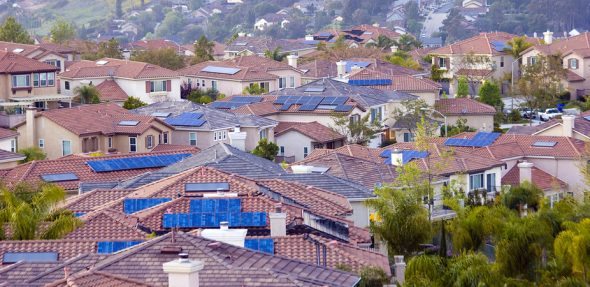In Australia’s middle and outer suburbs, rooftop solar technology provides a clear way to reduce the emissions from the energy our houses use. But higher density housing types (apartments and medium density housing) do not lend themselves to rooftop solar at the scale needed to make a difference to household energy and carbon budgets. So how will those people living in inner suburbs make the change to lower-carbon energy?
We believe the urban fabric will shape the transition to low carbon futures in both transport fuel and renewable energy (see Figure 1 below). The approach we suggest makes a distinction between relatively easy technological changes and more difficult structural changes.

Figure 1: Model framework for low carbon technology interventions in urban and suburban forms of the built environment.
There are easy technological substitutions for transport that can be adopted in inner areas: reducing car use and increasing sustainable transport. There are easy technological substitutions for dwelling energy use that are now becoming feasible for lower density outer suburbs – as shown by the new data presented here. But there will need to be harder structural changes in both areas as well.
What’s happening on our suburbs’ roofs?
Australia’s major cities dominate installed rooftop solar capacity. Adelaide, Brisbane and Perth are punching above their weight (see Figure 12 below). There are also a large number of non-metropolitan regions with high levels of solar installation; these include the Hunter, Sunshine Coast, Richmond-Tweed, and Wide Bay–Burnett.

Figure 2: Electricity generated by solar PV by statistical division. Derived from data supplied by ORER (Clean Energy Australia)
The geography of take-up of solar within Australia’s major cities is distinctive (see figures below; all produced from data provided by Clean Energy Australia; Office of Renewable Energy Regulator). A mapping of postcode areas with above average installed solar PV capacity over the period 2001 to 2011 reveals a clear spatial divide between the suburbs and the inner city.

Figure 3: Above average solar installation in Sydney, Melbourne and Brisbane.

Figure 4: Above average solar installation in Adelaide and Perth.
Rooftop solar has rapidly and easily diffused in the outer car-dependent suburbs of Australian cities. This is likely to continue as the space and cost for installing the technology seems to be available in a way that fits household budgets.
To save fossil transport fuel however, people in the outer suburbs will need more than the household-based approaches that rooftop solar can provide. They will be relying on government support – both policy and infrastructure. They will need structural redevelopment (beginning in the middle suburbs where housing redevelopment is now a priority due to the age of the housing stock).
This will need to be supported by new urban policy and practices that enable better transit and active transport such as walking and cycling, as well as policies and car charging infrastructure so these can be supplemented by electric vehicles.
Regenerating the established, middle suburbs of Australia’s cities will not be easy or fast, but it will have to happen if cities are going to become more sustainable. We have outlined some pathways for intervention in our paper Greening the greyfields.
What’s happening on our inner-city roads?
The higher density central and inner suburbs of Australia’s cities will reduce their energy use in different ways. For them, the easy route is to reduce their transport fossil fuel use. They will more easily switch to sustainable transport modes.
New light rail lines will be viable as the structural form of the city was built with them in mind. Short commutes mean that people in these areas are more likely to buy electric vehicles.
The challenge for these suburbs will be reducing their dependence on the fossil-fuel-dominated power grid.
Higher density areas such as these do not lend themselves to putting solar cells on every roof. But a structural change could help denser areas participate in a low emissions energy future, relying on precinct scale energy systems.
These energy systems are typically gas powered (natural gas, biogas etc) cogeneration or trigeneration (electricity plus heating and cooling) systems. They can service local areas as long as there are sufficient users within a reasonable distance to provide economies of scale.
When these systems have developed and been applied globally in recent years it has been in denser inner urban areas. This is a difficult structural transition for any urban area but the inner areas are more likely to find this process viable as the distances for distribution are short.
The new transition theory outlined here for low carbon urban development enables cities to recognise that simple technological substitution is possible in some parts of the city and deeper structural change is needed in others.
Both types of urban areas can begin decarbonising their built environment using relatively simple approaches that do not radically change their urban fabric.
However, urban planning and technology strategies need to be tailored to the specific spatial and structural challenges and opportunities that these different urban fabrics are actually presenting.
At least it is now clear that the outer suburbs have a way to begin.
Peter Newton is a Research Professor in Sustainable Urbanism at Swinburne University of Technology. He received funding for this research from the Australian Research Council (Discovery Project: Green Shoots? Exploring the Genesis and Development of a Green Economy in Australia). He is affiliated with the CRC for Low Carbon Living.
Peter Newman is Professor of Sustainability at Curtin University. He received funding for this research from the Australian Research Council (Discovery Project: Green Shoots? Exploring the Genesis and Development of a Green Economy in Australia). He is affiliated with the CRC for Low Carbon Living.![]()
This article was originally published at The Conversation.
Read the original article.








